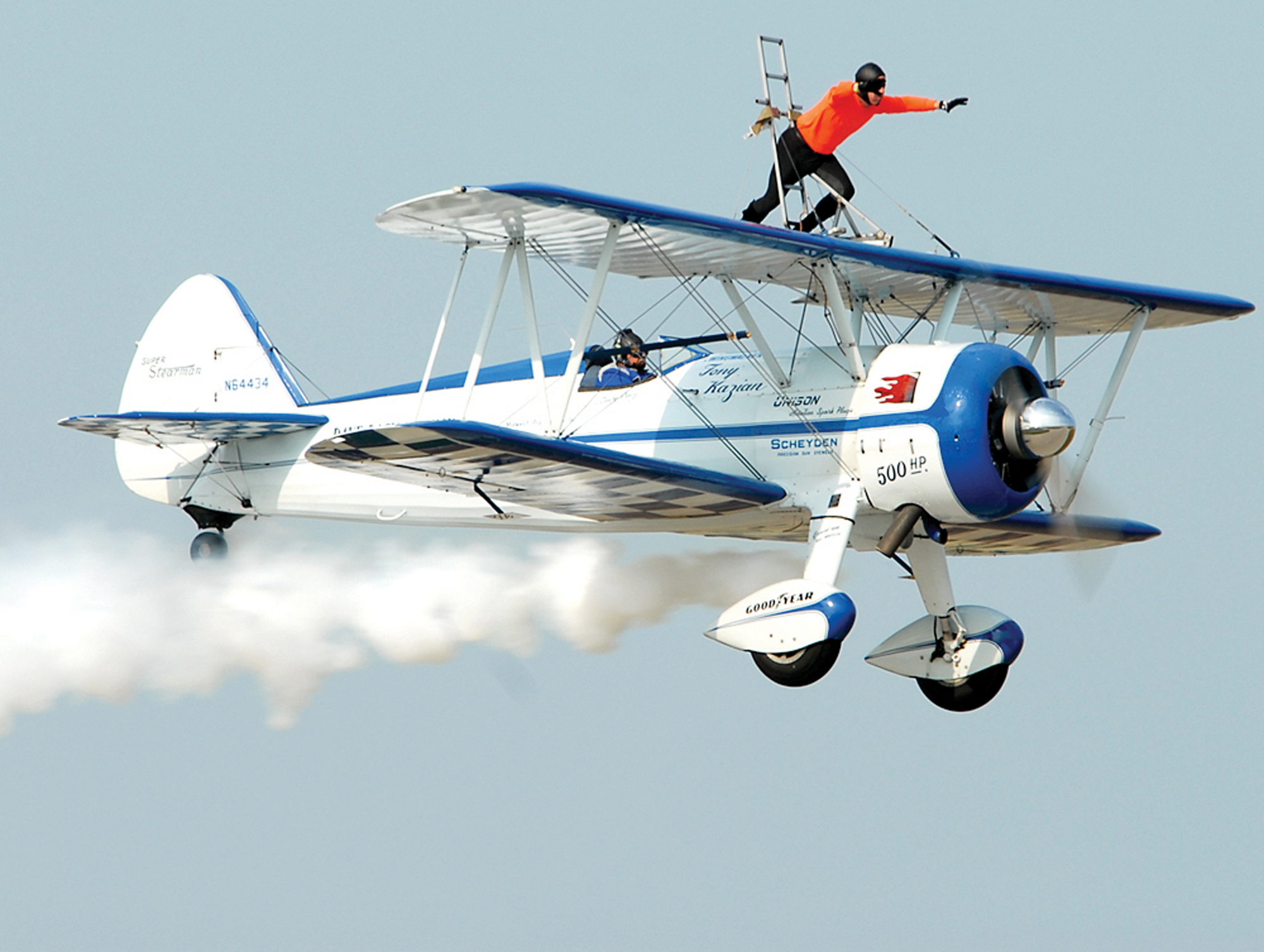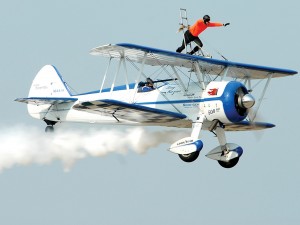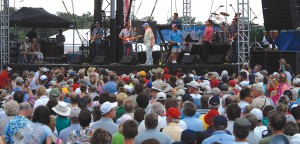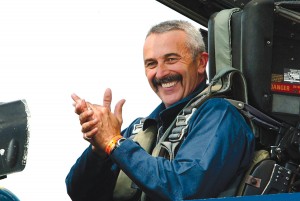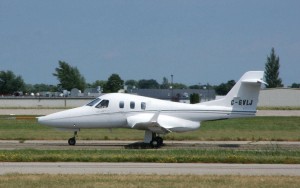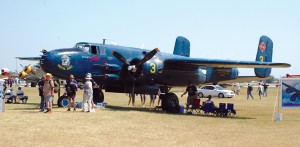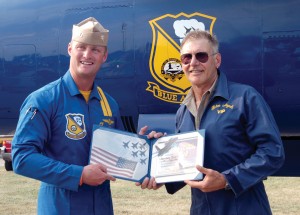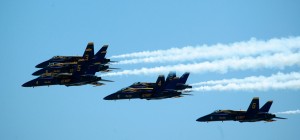By Henry M. Holden
Each year EAA AirVenture Oshkosh has a new theme, but the underlying theme is always innovation. That spirit of innovation was illustrated all week July 24-30. Breaking news announcements included the Eclipse 500 certification, the unveiling of two new Cessna piston airplanes, and the Honda decision to move into jet production and partner with Piper Aircraft. Those announcements all made for an exciting show attended by more than 625,000 people. There were more new aviation announcements this year than any EAA fly-in in history.
From Beach Boys to Blue Angels
This year’s AirVenture was filled with firsts. Opening day saw the first official rock concert as the Beach Boys performed in AeroShell Square. For more than two hours they played and sang their greatest hits and the crowd of several thousand rocked on.
The newest Air Force fighter, the F-22, Raptor made several flybys in what amounted to possibly the most exciting and noisy 15 minutes of the convention. Military aircraft such as the B-1B bomber, C-17 transport and A-10, F-16 and F/A-18 fighters also made appearances.
The Blue Angels, one of the world’s greatest aviation teams, and their F/A-18 Hornets made several formation flybys on July 28. This appearance was in addition to the previously announced program by one of the Blue Angels aircraft and pilot, Lt. Kevin “Kojak” Davis and his No. 7 Hornet. During his stay, Davis gave a special evening program at EAA’s Theater in the Woods. His F/A-18 Hornet was parked on AeroShell Square.
A record museum crowd joined Burt Rutan and Mike Melvill to dedicate the new SpaceShipOne exhibit. And the 1.25 millionth Young Eagle was announced during the week.
For warbird enthusiasts, this was a great week. More than 300 were flying, including fighter airplanes from World War II and classic fighter jets such as the F-86 Sabre and the MiG 17. The appearance of one of only two airworthy Lancaster bombers was quite an event. When it wasn’t flying, it made a great place on AeroShell Square for photo ops for visitors. The “Big Bomber Reunion” saw the rare British Lancaster bomber, a vintage B-24, plus a B-17 and a B-25. Hundreds of warbirds lined the grass and concrete of the field, drawing thousands of fans, admirers and visitors. Aside from the always exciting air show performances, there were special programs devoted to individual aircraft like “Warbirds in Review” and “Training Command” displays.
The American Barnstormers Tour, with aircraft representing the vintage aircraft from the “Golden Age of Aviation,” flew into AirVenture as part of a successful conclusion to their nine-city tour. The 20 aircraft from the 1920s, ’30s and ’40s made a unique collection of airplanes. The meticulously restored and maintained aircraft were featured in a special display in AirVenture’s Vintage Aircraft area and flown in showcase flights during their stay at Oshkosh.
VLJ Updates
Eclipse 500 certification

One word—certified—says it all for the Eclipse 500. The aircraft on the left belongs to DayJet, the first company to purchase the jet for short routes and air taxi use.
It was just seven years ago that Eclipse CEO Vern Raburn announced a plan to build a small jet unlike anything else then on the market. At AirVenture, Eclipse took possession of an official type certificate from the FAA, calling it “probably the most significant piece of paper that will truly change the face of aviation.”
Eclipse flew in 170 employees, most wearing T-shirts proclaiming, “We did it.” Those employees cheered as Raburn accepted the certificate from Maria Cino, acting secretary of transportation. The certificate is provisional, and won’t allow the company to start customer deliveries yet. The provisional nature of the aircraft’s certification is based in part on failure of the composite tip tanks in lightning strike tests, so larger aluminum ones will go on the fully certified model. The increased size of the tanks allows the 500’s IFR range to stretch to 1,125 nm, much closer to the original targeted spec of 1,280 nm.
Full certification is expected by the end of August. In the interim, the company can start to train pilots in the jet.
“This announcement is significant because it means we anticipate no further major hurdles in the process to award full type certification to the Eclipse 500,” Raburn said.
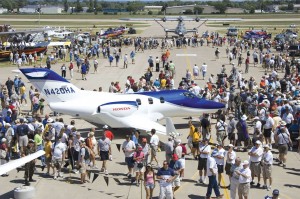
The announcement to go forward marketing the HondaJet comes one year after the plane made its world public debut at EAA AirVenture 2005.
Raburn said that Eclipse is dedicated “to expanding access to private jet travel throughout the nation, particularly in areas that are currently under-served by commercial airlines.” Toward that goal, Eclipse announced that four more sites will open by the end of this year, in addition to factory service centers now in the works for Albuquerque, N.M.; Gainesville, Fla.; and Albany, N.Y.
Eclipse’s goal is that by 2008, an Eclipse Service Center will be within a 60-minute flight of virtually all customers in the lower 48 states.
Honda-Piper alliance
For years people have been coming to AirVenture to see the GA aircraft and warbirds, and to show off their homebuilt airplanes. That’s still the case, but lately attention has been shifting to the light-sport aircraft category and to the very light jets. Virtually all of the VLJ manufacturers had exhibits at AirVenture, and there were some surprises.
Honda announced the formation of a new company and said it will begin taking sales orders in the U.S. this fall. The announcement to go forward marketing the HondaJet comes one year after the plane made its world public debut at EAA AirVenture 2005. Honda Aircraft Company, a wholly-owned subsidiary, will be responsible for the further development, sales promotion and production of the innovative HondaJet. The new company will be based in a facility at Piedmont Triad International Airport in Greensboro, N.C., where the prototype was assembled and flight testing has been carried out for more than three years.
The new company will hold both FAA type and production certification. Honda’s goal is to complete type certification in three to four years, followed by the start of production in the U.S., and the first mass production HondaJet in 2010.
The HondaJet features several innovations that allow it to achieve better fuel efficiency, larger cabin and luggage space, and higher cruise speed than conventional aircraft in its class. It has a natural laminar flow wing and all-composite fuselage, but its most distinctive feature is its engines mounted on pylons above the wing, rather than attached to the aft fuselage, as other business jets.
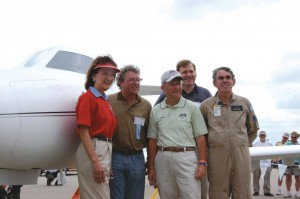
L to R: FAA Administrator Marion Blakey, Diamond Aircraft CEO Christian Dries, EAA President Tom Poberezny, Diamond Aircraft President Peter Maurer and D-Jet test pilot Anthony Brown in front of the D-Jet.
Since 2003, the prototype has completed more than 240 hours of flight-testing. The prototype has climbed to an altitude of 43,000 feet and a speed of 412 knots. It’s on course to meet or exceed all of its design specifications.
Honda also announced intentions to form a business alliance with Piper Aircraft. The two plan on collaborating on sales and service, and to explore opportunities in engineering and other areas. No specific details regarding additional collaboration were announced.
Piper Aircraft President James Bass said the new arrangement signals the launch of “a significant and meaningful relationship” between the two companies.
“The synergy will extend through sales and service to engineering collaborations and beyond,” he said.
There’s no merger or takeover in the works, and Bass said the arrangement won’t affect Piper’s plans to develop a jet of its own.
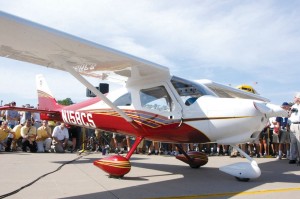
The Cessna Sport is Cessna’s proposed entry into the LSA field. The high wing spans 30 feet, and the aircraft provides side-by-side seating in a 48-inch-wide cabin (about six inches wider that a Cessna 152).
“There’s plenty of room in the market for a Piper jet that wouldn’t be going head-to-head with Honda,” said Bass.
When asked if that meant Piper would offer a smaller, more personal-size jet, Bass said “You could make that assumption.” He added that Piper would have more to say about plans for their own product line in the fall at the NBAA convention.
Point2Point Airways
Acceptance of the “per-seat, on-demand” concept for hard-to-reach regional jet service is growing. In April, Dayjet, of Delray Beach, Fla., announced they would soon begin service in the new Eclipse 500 personal jet. At AirVenture, Point2Point Airways, a taxi/charter company based in North Dakota, announced they will place orders for up to 100 airplanes from Diamond Aircraft.
“We aim to be the world’s first personal airline,” said Point2Point CEO John Boehle.
Diamond will deliver 10 of its DA42 TwinStars starting next month. The DA42 has a carbon composite airframe and a fully integrated Garmin G1000 glass cockpit. It has twin jet, fuel-burning TAE Centurion 1.7 turbo-diesel engines.
“The TwinStar is the right size and has the right capabilities to meet the growing needs of his company,” Diamond President Peter Maurer said. Point2Point’s order represents the first sale of Diamond’s DA42 TwinStar to a U.S. commercial air carrier. The TwinStar can carry a pilot and up to three passengers at 200 mph with a range of up to 1,300 miles.
“The TwinStar also is certified to fly into known icing conditions, which is vital for reliable all-weather dispatch,” said Maurer.
Boehle also holds delivery options for the D-Jet, which made its public debut at this year’s AirVenture. The D-Jet can cruise at a speed of 362 mph with a range of 1,553 statute miles at an altitude of up to 25,000 feet. The prototype landed briefly, but a full-size mockup was on display all week. The interior, with two seats up front and a double bench seat in back, is roomy, and the copilot seat can swivel around for “club seating.”
Diamond CEO Christian Dries said the D-Jet is “extremely comfortable” to fly in. So far, it’s logged about 30 hours aloft. Labeling it as a “personal jet,” Dries said its target market is the 500- to 700-hour turbo owner-pilot. The jet will be certified up to 25,000 feet, which Dries says is a safer altitude.
“At that altitude, if there is a pressurization failure, you have about three minutes to react,” he said. “At 40,000 feet, you’d have about one to three seconds. Up there, you pass out, and then you pass away.”
The D-Jet also will include a whole-aircraft ballistic parachute, under development by BRS. Dries says the lower altitudes are safer and the aerodynamics are easier to manage. The single-engine jet has a Williams FJ33-4 engine and Garmin 1000 glass cockpit. It’s expected to be on the market in 2008.
Other VLJ news
On Thursday, Joe Walker, president of Adam Aircraft, and Rick Adam, founder and CEO, updated the media on the changes and challenges the company is facing as it prepares its forthcoming A700 jet to join the gaggle of very light jets soon to fly the skies.
The A700 is a jet-powered derivative of the piston-powered A500 twin. With eight seats, the A700 is a bit larger than its competition, and Adam has two aircraft in the certification process.
Concerning progress toward A500 full certification, Rick Adam said all of its facilities have passed the FAA inspection required for the agency to issue a production certificate, and night/IFR certification is pending. The company expects to receive the production certificate in the third quarter of the year.

Cirrus, which sponsors Aerobatic champion Patty Wagstaff, confirmed that there is a “personal jet” in the company’s future.
Adam pointed out that while the company is both manufacturing and delivering new A500 piston twins, it’s eager to get the A700 jet completely through the certification process. The company is hopeful that it may not be as challenging as getting complete certification on the A500, since the two types share many common parts. This may also mean that the static and flight testing required for the A700 may be less.
The two flying A700 prototypes have more than 550 flight hours between them, with serial number 2 setting a Denver-to-Oshkosh record on July 7. The aircraft covered the distance between the two cities in 2.62 hours, for an average speed of more than 348 mph.
To date, the mix of piston- and jet-powered aircraft in Adam’s fleet have accumulated more than 3,600 total hours. Despite limitations imposed on the A500’s original certification, by December, the company expects to begin delivering two of the piston twins each month. The 20th A500 is in the production flow while the company expects to deliver serial number eight next month.
Cessna-Textron announced that the Citation Mustang is on track for FAA certification later this year, and European Aviation Safety Agency certification in the second quarter 2007. The six-seat business jet will be certified as a FAR Part 23 aircraft, with a cruise speed of 340 KTAS, and maximum operating altitude of 41,000 feet.
The three Mustangs flying the certification program have flown 850 flights and accumulated more than 1,400 flight hours. A fourth Mustang made its first flight in June, two weeks ahead of schedule, and will serve as the marketing demonstrator aircraft later this year.
There is serious interest in the Mustang. With 250 orders flowing in, it’s sold out into the third quarter of 2009. Currently, about 60 percent of Mustang orders are from outside of the United States, with 30 percent from Europe. Other significant markets include South America and Australia.
Aviation Technology Group’s Javelin is a departure from what one might expect a VLJ to look like. It looks more like an advanced military trainer styled along the lines of an F-18 than a business jet. The two-seat Javelin is still intended to be owner-flown, and is planned to be faster than the more conventionally configured competitors.
Excel-Jet’s single-engine Sport-Jet prototype recently took to the air but unfortunately was damaged in an accident last month. Excel-Jet brought the prototype fuselage to AirVenture. Development is continuing.
Cessna Enters LSA Market
Earlier this year, Cessna announced that it was studying the feasibility of developing a light-sport aircraft. During AirVenture, Cessna unveiled its highly anticipated proof-of-concept special light-sport aircraft before a large crowd at Aeroshell Square.
Cessna’s proof-of-concept has a high wing spanning 30 feet, and two-place, side-by-side seating in a 48-inch wide cabin (about six inches wider than a Cessna 152). Upward opening doors allow access to the cockpit, and it has large windows and dual control sticks.
The Cessna Sport sits on a tricycle gear and steers (on the ground) with a castering nose wheel and toe brakes. A 100-hp Rotax 912 engine pulls it. It weighs 1,320 pounds, and has an airspeed of 120 knots, both the maximum allowable under the LSA rules. Construction is aluminum, with selective use of composites for the cowl, wing and dorsal fin. Cessna claims its new S-LSA may not lead to a commercially available design, but many in the LSA community expect Cessna to begin production in the near future.
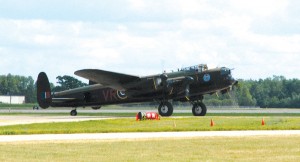
One of only two Avro Lancasters still flying in the world visited AirVenture 2006. One is in The United Kingdom, while this one is based in Canada.
Jack Pelton, Cessna president and CEO, said first flight of the aircraft is planned for later this year, and says feedback and public acceptance of the aircraft will help to determine whether the company will enter into the LSA field. He cautioned that no decision will be made before the first quarter of 2007.
“We want to make sure that this aircraft is what the market wants,” he said.
No price has been published, but Pelton claims that if the aircraft is produced, it will be competitive with other LSA on the market. Cessna hopes to bring their LSA offering in for under $100,000.
“If we can do that, I think the market is very much there,” he said, adding that even that won’t be easy. “As you dissect the cost, and if you do business as usual, we’ll never make the price point.”
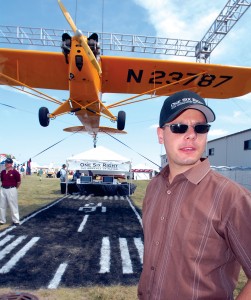
Brian Terwilliger, producer and director of “One Six Right,” beneath a Piper Cub similar to one featured in the film. Terwilliger and the American Legend Aircraft Company presented two screenings of his 73-minute film.
As Pelton spoke of the possibilities of the new LSA, a voice behind the podium began counting down: one minute. 30 seconds. and then Pelton directed the crowd to look toward the flight line—for the dramatic flyby of Cessna’s Next Generation Piston.
The new aircraft didn’t land, and Cessna is saying little about this aircraft. What could be determined from two flybys is that it’s a single-engine piston, fixed-gear, high-wing, and is at least a four or five-place aircraft. The NGP features a cantilever forward-swept wing and advanced fuselage shaped with compound curves, with front and back access doors, plus a baggage door. The aircraft has flown about 20 hours, and Pelton said it was too early to release performance numbers or specifications.
“We’re confident it will be a world-class airplane. It’s our baby,” Pelton said.
Cirrus Confirms Personal Jet
At a press conference, Alan Klapmeier, CEO of Cirrus Design, reminded those gathered what he said earlier this summer.
“We’re going to do a personal jet, which, of course, you all knew, but we were pretending that it wasn’t quite decided,” he said. “And we did get the rest of the board of directors to agree.”
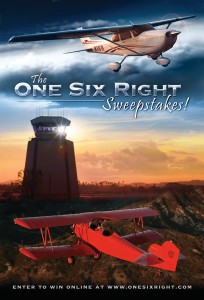
The grand prize winner and a guest will get an all-expense paid trip to Los Angeles to visit the set of “One Six Right.”
“He wouldn’t give many details about the aircraft but did say it would be powered by a single engine and have an airframe parachute.
I have no pictures, no specifications, no price, and no dates to announce,” he said. “Such details will be forthcoming at a later date. It would be a logical step-up path for Cirrus owners. It will be the lowest, slowest, and shortest-range aircraft in the small-jet field.”
He said the personal jet will be aimed at “existing SR20 and SR22 pilots who are ready to move up to a more capable airplane.”
Cirrus also announced a new program designed to deliver what most prospective pilots want: the immediate value and convenience of personal flight, with a clear path through the challenges of ownership, training, operation and maintenance. Dubbed Cirrus Access, the new program will incorporate flight training, licensing, insurance and other details that often overwhelm a prospective pilot.
“The industry needs to do a better job promoting aviation to the non-flying public,” Klapmeier said. “One way Cirrus can do that is by offering Cirrus Access, making it easier, faster, and more fun to learn how to fly and own a Cirrus airplane. In my opinion, there’s no better way for a new owner/pilot to get safe utility with their aircraft.”

Brian Terwilliger discusses “the romance of flight” with NAHF Executive Director Ron Kaplan and “Flyboys” Director Tony Bill.
Cirrus also announced introduction of a new SR22 model. Called the Cirrus Signature Edition, the new model celebrates the birth of the company 22 years ago, in Baraboo, Wis. The SE stands out from the rest of the fleet by featuring exterior red and yellow stripes over a checkered flag pattern. The black leather seating is highlighted in red stitching. Also, the unique SE has the signatures of both Alan and Dale Klapmeier on the fuselage.
Van’s Aircraft
The largest aircraft kit maker, Van’s Aircraft Inc., of Aurora, Ore., displayed components of a proof-of-concept version of their RV-12. The RV-12 is Van’s first effort to build a kit in compliance to the S-LSA standard. Features for the kit include removable wings, full-span flaperons, and an all-moving stabilator.
The Rotax 912S 100-hp engine will power the RV-12. It’s the same engine expected to power the Cessna LSA, and the engine of choice for many of the available S-LSA models.

“One Six Right” tells the thrilling story of Southern California’s famed Van Nuys Airport, the country’s busiest GA airport.
The airplane will most likely be offered first as a standard Van’s kit, and then upgraded to a fast-build kit option. An S-LSA kit option, where the builder is required to complete at least 51 percent of the construction, is under consideration, the company said. According to Van’s, a factory built, fly-away version of the airplane will not be available. Pricing for the kit is expected to be similar to prices for other Van’s kits. A prototype airplane is expected to fly in October of this year, and kits are expected to be available in late 2007.
“Flyboys” Debut
The major motion picture “Flyboys,” set for release across the nation on Sept. 29, 2006, debuted at EAA AirVenture. The film’s producers are calling it the movie’s “aviation-world premiere.”
“Most major motion picture premieres take place in New York or L.A., but we chose to bring the film to the gathered aviation community in Oshkosh, Wisconsin,” Director Tony Bill said. “It may be in America’s heartland, but for one week every July, Oshkosh is the world’s heart and soul of aviation. There is no better place to debut a film with such a pervasive aviation theme.”
EAA President Tom Poberezny said that Hollywood recognizes that Oshkosh is the place to be for celebrating aviation.
“This film’s premiere reflects on the importance of AirVenture to the aviation community and to people everywhere who are passionate about flight,” he said.
Inspired by the true story of the legendary Lafayette Escadrille, the movie tells the story of a handful of young Americans who volunteered to join the French forces in World War I before the U.S. entered that war. They trained to become pilots and formed a unique squadron flying combat missions against the Germans.
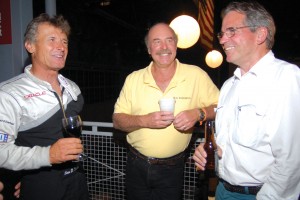
Tony Bill (right) visits with Sean Tucker (left) and Kermit Weeks at the premier of his new movie, “Flyboys.”
Assigned to their own squadron, the new aviators are commanded by the battle-weary French Captain Thenault (Jean Reno), and an equally battle-scarred American pilot, Reed Cassidy (Martin Henderson), the cynical sole survivor of his group. Ignoring Cassidy’s grim admonition to quit and go home before they meet their inevitable fates, and snubbed by the other aviators as unqualified to call themselves “killers,” the mismatched boys study, train and finally learn to fly.
Fighting a war that wasn’t yet theirs, these young, naïve adventure-seekers slowly learn the true meaning of love, brotherhood, heroism, courage and tolerance, and in return, gain a true reason to risk their lives.
Forced to abandon his family’s ranch, Blaine Rawlings (played by James Franco) finds his future in a newsreel chronicling the adventures of young aviators in France.
Real-life aviator and aerobatic pilot David Ellison making his film debut, plays Eddie Beagle, an eager young man whose past is mysterious to his copilots and superior officers. When one of his copilots grows suspicious that Beagle might be a spy for the Germans, he must face the grueling decision of telling his comrades the truth or be charged with treason.
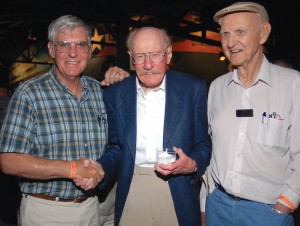
Dick Rutan, Bob Hoover and Rutan’s dad, George Rutan, were among those who attended the premier of Tony Bill’s new film.
Ellison began flying when he was 13 and has performed for thousands at air shows around the world. In 2003, he was chosen as one of the “Stars of Tomorrow,” six of the best aerobatic pilots in the country. In competition, he flies a French CAP 232, a premier aerobatic aircraft and the plane of choice for the world’s best aerobatic pilots.
Academy Award winner Tony Bill, the film’s director, produced “The Sting.” Dean Devlin and Marc Frydman produced the film. Devlin’s credits include “Independence Day,” “The Patriot” and “Stargate,” and Frydman’s include “Commander In Chief” and “The Jacket.”
Jean Reno has stared in almost 50 films, including “The Professional,” “The Pink Panther” and the “Da Vinci Code.” James Franco’s previous movies include “Spider-Man” 1 and 2, “Tristan & Isolde” and “Annapolis.” Martin Henderson stared in “The Ring” and “Torque.”
Tour and Sweepstakes Announced for “One Six Right”
AirVenture saw Brian J. Terwilliger, producer/director of the acclaimed aviation documentary “One Six Right,” present two screenings of his 73-minute film. Terwilliger’s mission is to preserve the country’s vanishing general aviation airports and to inspire a new generation of pilots through the film media.
“One Six Right” tells the thrilling story of Southern California’s famed Van Nuys Airport (VNY), the country’s busiest GA airport. Pilots, air traffic controllers, aviation pioneers, historians and flight enthusiasts combine to tell the history of this airport. It’s a rich history that includes the discovery of Marilyn Monroe while working in its hangars, and the filming on its grounds of scenes from the classic film “Casablanca.”
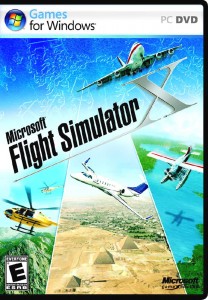
The standard version of Flight Simulator X has 40 highly-detailed airports (16 new to this version), 28 highly-detailed cities and 30+ structured missions.
“This film goes beyond the aviation community, inspiring people of all ages and interests to experience the beauty and passion of flying, while telling the story of one of the most exciting airports in the world, ” says Terwilliger, a passionate pilot who learned to fly at VNY and spent more than five years making his cinematic love story.
The film has been widely acclaimed, and touches many people. Actor Harrison Ford says “One Six Right” captures the spirit, joy and beauty of flight.
“It’s one of the finest aviation films ever made,” he said.
A pilot from Decatur, Ga., said he had been going to give up flying until he saw the film.
“Thanks for reminding me why I got my pilot’s license,” he said in a letter to Terwilliger.
Another pilot wrote Terwilliger and told him that he tried hard to hide his tears from his wife while watching “One Six Right.”
“But I think she understood,” he added.
While the film has a healthy dose of nostalgia, it also has a serious message: we are losing our general aviation airports at a rate of one a week. In the greater Los Angeles area, at one point there were 66 GA airports. Today there are nine. Growing populations, noise, real estate development and increasing property values are the main causes of the decline of airports.
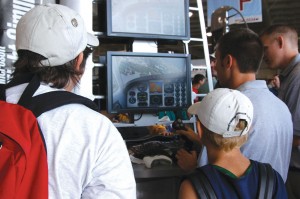
Microsoft Flight Simulator X, due out in October 2006, drew hundreds of gamers, pilots and curious folks.
“The movie has already created a real ground swell of interest in Van Nuys,” said Terwilliger. “Air traffic controllers are telling me that people are flying into it just to land on One Six Right. If a fast mover is overtaking a slow airplane, the controller asks the slow airplane to move ten degrees left to land on that runway. They tell me that pilots are getting upset and refusing to do it. They’d rather go around. That’s was one of those unintended consequences.”
On August 9, Terwilliger announced a 12-city, three-month tour of the film and a thrilling sweepstakes.
“We’re very excited about this,” said Terwilliger. “The grand prize winner and a guest will get an all-expense paid trip to Los Angeles to visit the set of the film. We’ll fly them first class to LAX, and ferry them to Van Nuys Airport via private helicopter, with a tour of Hollywood by air. The winner will have an opportunity to pilot the planes from the film—the P-51, Piper Cub, Fleet Biplane and Pitts—and fly with Clay Lacy in his DC-3 for an afternoon that will include lunch in Santa Barbara.”

This is a screen shot of the virtual cockpit of a Bombardier Canadair CRJ700. The graphics look more realistic on a 30-inch or larger flat screen.
The grand prize also includes dinner with Bob Hoover, Barry Schiff and others from the film, three nights in the Airtel Plaza Presidential Suite, a full-size rental car, $500 spending money and a limo back to LAX.
First prize is an all expense paid pilot’s license, including 60 flight hours in a Cessna 172, a $1,000 Sporty’s gift certificate, and much more. The value is more than $18,000. Anyone over the age of 18 is eligible to enter. The city tour list and additional prizes, along with an entry form, can be found at [http://www.onesixright.com].
Microsoft Flight Simulator X
Microsoft was back at AirVenture with a new version of their highly successful Flight Simulator. Next year marks the 25th anniversary of Microsoft Flight Simulator. In 1982, the game won the “most unusual game concept,” and in many ways it still holds true today.
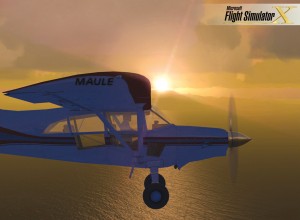
Flight Simulator X puts the user in the aircraft of his or her dreams. The user can modify the livery on this screen shot of a Maule M7-260C.
It’s been almost three years since Microsoft Flight Simulator’s Century of Flight 2004 edition let you trade places with the Wright brothers in their Wright Flyer. The newest version, Microsoft Flight Simulator X, has made major advances in realism and introduced new multiplayer modes. For many pilot wannabes, it may be the next best thing to flying, and while it’s not for actual flight instruction, it may be a good tool for instrument pilots looking to keep their skills up.
The FSX graphics of the land forms and oceans are strikingly realistic and are based on NASA’s space shuttle mapping of the digital elevations of earth several years ago. The terrain resolution is 16 times higher than the previous version, and there are as many as 6,000 scenery objects in a square kilometer. The software models the sun and phases of the moon, and with 10,000 stars accurately placed in the sky, the user can navigate by the stars.
Of 24,000 airports, about 1,200 have detailed infrastructure, such as moving jetways, baggage and pushback tugs, giving action to the concept of a dynamic ground environment. Other computer-controlled aircraft are moving on the ground and in the air, and the user can hear the chatter of the air traffic controller as part of the drama. In this version, the user isn’t alone in front of a PC, but part of a drama that is unfolding around him or her.
There are new aircraft in this version and Microsoft has taken a new approach. The focus is on the experiences, and Microsoft has invested in three areas. The first is the “dynamic living world,” the environment the user is flying. The second focus is “the mission component,” where the user has something to do. The third is “shared skies,” where people are connected to share their passion to fly.
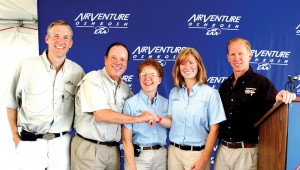
After accepting her grant, Lesley A. Weitz (second from right) poses with, L to R, Erik Lindbergh, John and Martha King and Ian Walsh, vice president and eneral manager of Lycoming.
With more than 50 missions in FSX, there’s something for everyone, whether you’re an experienced user or just beginning to explore the world of flight. From learning to “fly” a Cub off the ground, to challenging pilot scenarios such as losing an engine in a 737, there’s something for every skill level. There’s even a flight recorder and flight analysis built in for those who want to debrief their mission.
FSX allows users separated by thousands of miles to share the sky. The new multiplayer modes let two pilots in the same room or around the world share the cockpit over the Internet. A simple keyboard command (shift T) allows transfer of the pilot-in-command function to the copilot.
There are 3,100 controlled airports in the product. A virtual model of a control tower with all the frequencies allows the user a 360-degree view of the airport, along with the radar screen and other instruments. The tower controller can even track who is in the session, and where they are.
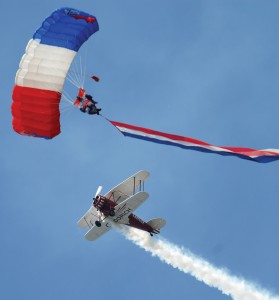
The Goodrich Waco, flown by air show veteran Bob Wagner, circles a Liberty parachute team member during the opening ceremony.
If the user has an Internet connection, he or she can tap into 5,000 live weather stations around the world (with a 15-minute delay for security reasons) and update their weather. If the users don’t like the real weather, they can create their own.
There are 24 player-flyable aircraft, and the user can change the livery on all of them. Microsoft has added a tow plane to this version so the sailplane pilot doesn’t have to cheat his way into the air. Skin and bone has been added to the sailplanes so the user can see the wings flex if in a thermal. There are about 200,000 add-on objects online that the user can download to FSX.
What has been missing in previous flight simulators is the dynamic feeling of flight. In FSX, Microsoft rewrote the sound engine, which now combines the voice communication, going through a headset, and the engine noise, driven though surround sound speakers. If the user turns up the volume, the vibration can be felt. It’s “almost” like being in an aircraft.
There are two versions of the product, a deluxe version and the standard version. The standard version has 21 new and legacy aircraft and includes shaded rivet, reflective paint and a choice of liveries. The dynamic world includes autos on highways and airport vehicles. The missions include flying up the Amazon River, rescuing a downed pilot and much more.
The deluxe version will appeal to the more devoted fan. It comes with everything in the standard version plus three aircraft—the Cessna 172, Baron and Mooney—equipped with the Garmin 1000 glass cockpit. Additional missions and scenery areas are added in the deluxe version, along with the tower controller experience and the software development kit. The SDK documentation allows the add-on community to more easily add their own items to the product.
FSX will be out in October. When Windows Vista ships in January, a new technology called Direct X 10 will allow even greater graphics presentation. Microsoft [http://www.microsoft.com/games/flightsimulatorx] will offer a free upgrade to anyone using Vista.
Lindbergh Foundation and Lycoming Establish Grant
Each year, The Charles A. and Anne Morrow Lindbergh Foundation provides grants of up to $10,580 (this symbolic amount represents the cost of the Spirit of St. Louis). The grants are given to individuals whose individual initiative and work in a wide spectrum of disciplines furthers the Lindberghs’ vision of a balance between the advance of technology and the preservation of the natural/human environment. To date, 270 men and women in the U.S. and abroad have received more than $2.6 million to support their work.
This year’s newly established Lindbergh-Lycoming Grant is the first grant to be awarded in the new partnership created by Lycoming Engines and the Lindbergh Foundation to specifically fund a project focusing on aviation/aerospace.
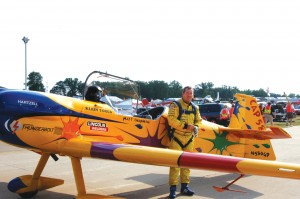
Matt Chapman began flying gliders when he was 11. He began aerobatics in 1984 and quickly worked his way up to unlimited competition flying. He currently flies a Mudry CAP 231EX.
This award went to Lesley A. Weitz, of Texas A&M University, for her project entitled “Reducing Fuel Inefficiencies and Noise Pollution from Aircraft by Exploring the Wider Use of Continuous Descent Approaches at Busy Airports.” Continuous descent approaches safely increase airport capacity, and decrease fuel consumption and emissions from aircraft. The CDA significantly reduces the noise of landing aircraft by keeping aircraft at higher altitudes on approach to the airport and reducing power during descent. Previous research has shown it to contribute up to a 17 percent reduction in fuel consumption over traditional descent methods. Results from her study will be published and shared with NASA Langley Research Center for possible integration with other air-traffic-management research.
The Lindbergh Grants program often provides seed money and credibility for projects that subsequently receive larger sums from other sources to continue and expand the work. Seventy-four percent of Lindbergh Grant recipients have received additional funding for their research or educational projects earlier supported by a Lindbergh Grant, with 48 percent of the recipients receiving $500,000 or more in follow-up support. Ninety-three percent continue their study beyond the term of the grant.
The grant program is open to anyone conducting an aviation/aerospace research project that will improve the quality of all life by balancing technological advancements with the preservation of our environment. The deadline for applications is Nov. 1, 2006. More information is available at [http://www.lindberghfoundation.org].











